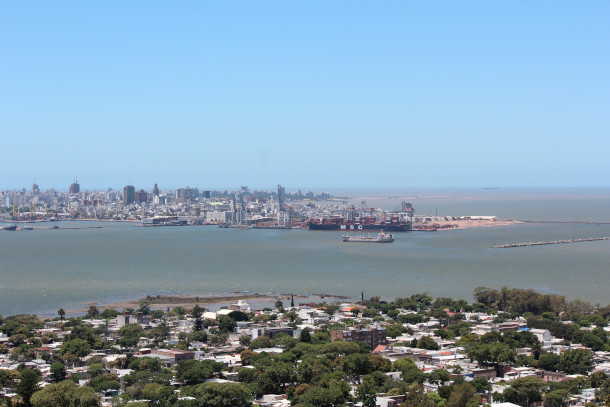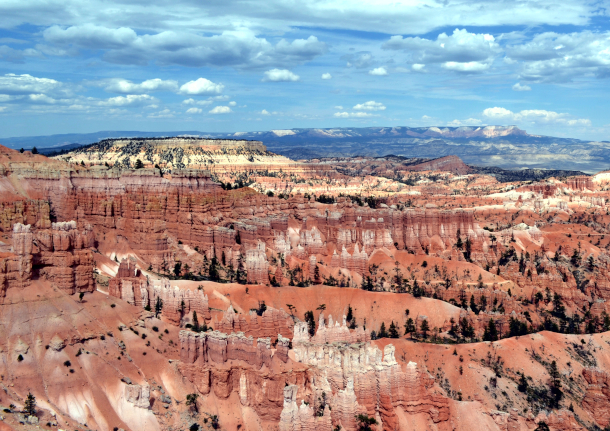Beyond the Headlines
Air Date: Week of June 2, 2023

Uruguay is using salt water from the Rio De La Plata to replenish drinking water resources. (Photo: Tania Malrechauffe, Unsplash, Fair Use)
This week, Living on Earth contributor Peter Dykstra joins Host Jenni Doering to share news of Uruguay’s salty tap water as a severe drought has forced managers to use estuary water to boost supply. Also, new research links plastic waste clogging up storm drains to a deadly flood in Mumbai in 2005. And in history, they wish Bryce Canyon National Park a very happy 100th birthday.
Transcript
CURWOOD: It’s Living on Earth, I’m Steve Curwood.
DOERING: And I’m Jenni Doering.
DOERING: It's time now for a look beyond the headlines with Peter Dykstra. He's Living on Earth’s contributor and he joins us from Atlanta, Georgia. Hey, Peter, what do you got for us this week?
DYKSTRA: I'm doing well, Jenni, hope you are too. There's news from the south, not the south like here in Georgia, but the south-south in Uruguay. There's a severe drought going on there, and one of the main reservoirs is as low as 5% of its capacity. That's lower than the heavily-taxed Lake Mead and Lake Powell, out in the western US. In order to fix that, they're introducing estuary water from the Rio de la Plata, a huge, huge bay that separates Argentina and Uruguay, that water is salty. And right now tests have revealed that some of the tap water offered to people in the most populous places in Uruguay is even more than twice the recommended level of salt in drinking water as set by the World Health Organization.
DOERING: Gosh, well, that doesn't sound very refreshing at all on a hot day, and sounds like it's unhealthy too.
DYKSTRA: Unhealthy because sodium is one of the precursors, in human health, to high blood pressure, and any number of other human maladies. So when you more than double the recommended level of salt in your drinking water, you're creating a big potential health problem for many Uruguayans.
DOERING: Peter, what are people supposed to do? I mean, I drink my tap water here. I rely on it.
DYKSTRA: The Uruguayan government has provided bottled water to people who are considered vulnerable to hypertension and some of the other things related to high levels of salt. The drought, of course, is said to be linked for the most part to climate change, or at least climate change is making it more severe.
DOERING: Yeah, Peter, climate change is bringing droughts and floods and fires and all manner of different apocalyptic things.

Plastic waste blocked storm drains in Mumbai, India which exacerbated the deadly flood of 2005, a new report by the charity organization Tearfund suggests. (Photo: Saikiran Kesari, Unsplash, Fair Use)
DYKSTRA: Well, let's go from drought to flood. Because in Mumbai, back in the year 2005, a flood that killed over 1000 people, it's finally been determined to have been caused largely by the flow of plastic towards storm sewers, that block those storm sewers, leading to the very, very high death toll.
DOERING: Wait, so you're telling me that plastic is not only causing, you know, the huge problems that we're seeing in the environment with animals ingesting it, especially in the oceans, but it's also piling up in storm drains, and potentially contributing to floods?
DYKSTRA: Plastic is getting us in a lot of different ways. And of course, it's a product with the petrochemical industry. So another tie there is that those petrochemical refineries are a source of greenhouse gas emissions that are the main culprit in our changing climate. All of this has led to an effort by the United Nations to bring together a global treaty to reduce plastic pollution by as much as 80% by the year 2040.
DOERING: Yes, they're meeting in Paris as we speak, these negotiators, and I think in the next couple of weeks, we'll have an update. Well, what do you have for us from the history books this week, Peter?
DYKSTRA: Here is something to salute on our history page this week. It's the 100th anniversary, June 8, 1923, of the Bryce Canyon National Monument declared by U.S. President Warren G. Harding. Five years later, in 1928, Bryce Canyon was elevated to full National Park status.

Bryce Canyon was named a National Monument in 1923 by President Warren G. Harding. The now National Park turns 100 on June 8th, 2023. (Photo: Alexander C. Kafka, Flickr, CC BY-ND 2.0)
DOERING: Yeah, those National Parks in Utah really are stunning, Peter, I mean, all these red rocks, the steep spires and crevices that Bryce Canyon has, I mean, it's been years since I was there with my family, but have you been there?
DYKSTRA: They're still on my bucket list.
DOERING: So, a very happy 100-year birthday to Bryce Canyon. Peter Dykstra is Living on Earth's contributor, and we'll talk to you again next week, Peter.
DYKSTRA: Alright, Jenni, thanks a lot. We'll talk to you soon.
DOERING: And there's more on these stories on the Living on Earth website. That's loe.org.
Links
The Washington Post | “Uruguay, Hot and Dry, Adds Salt Water to Public Drinking Supply”
The Guardian | “Plastic Waste Puts Millions of World’s Poorest At Higher Risk From Floods”
Living on Earth wants to hear from you!
Living on Earth
62 Calef Highway, Suite 212
Lee, NH 03861
Telephone: 617-287-4121
E-mail: comments@loe.org
Newsletter [Click here]
Donate to Living on Earth!
Living on Earth is an independent media program and relies entirely on contributions from listeners and institutions supporting public service. Please donate now to preserve an independent environmental voice.
NewsletterLiving on Earth offers a weekly delivery of the show's rundown to your mailbox. Sign up for our newsletter today!
 Sailors For The Sea: Be the change you want to sea.
Sailors For The Sea: Be the change you want to sea.
 The Grantham Foundation for the Protection of the Environment: Committed to protecting and improving the health of the global environment.
The Grantham Foundation for the Protection of the Environment: Committed to protecting and improving the health of the global environment.
 Contribute to Living on Earth and receive, as our gift to you, an archival print of one of Mark Seth Lender's extraordinary wildlife photographs. Follow the link to see Mark's current collection of photographs.
Contribute to Living on Earth and receive, as our gift to you, an archival print of one of Mark Seth Lender's extraordinary wildlife photographs. Follow the link to see Mark's current collection of photographs.
 Buy a signed copy of Mark Seth Lender's book Smeagull the Seagull & support Living on Earth
Buy a signed copy of Mark Seth Lender's book Smeagull the Seagull & support Living on Earth

